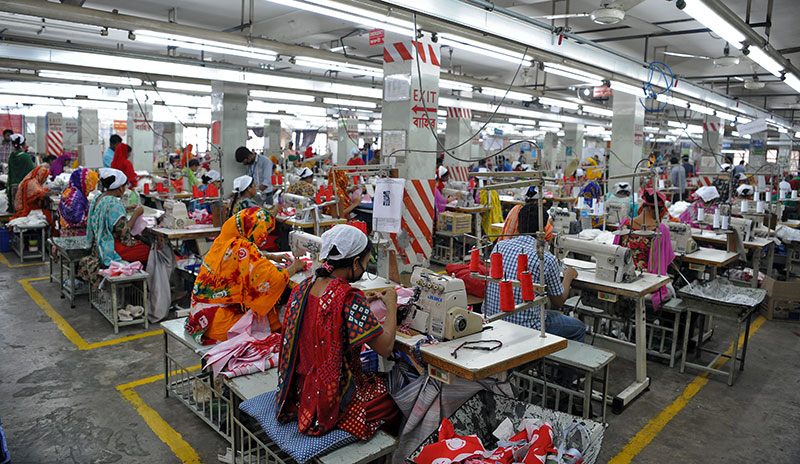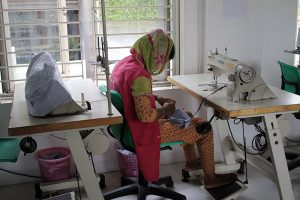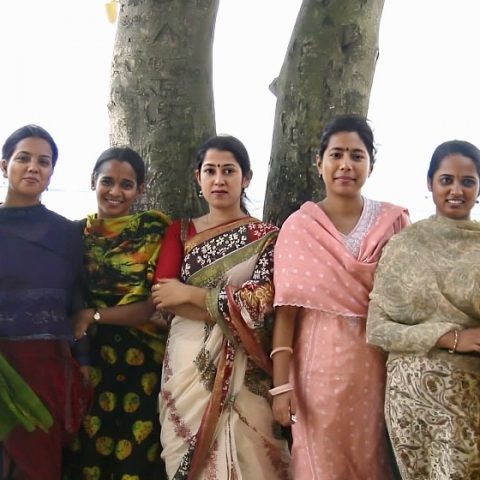One of the most prevalent public health issues plaguing the world today is violence against women and girls. Not only is this a violation of fundamental human rights, but the negative effects of such abuse can last a lifetime and even span generations, impacting the health, education, and employment of millions of women and their children. Within this spectrum is intimate partner violence (IPV), broadly defined as any form of violence in an intimate relationship that causes physical, sexual or psychological harm.

icddr,b researchers interviewed 800 female garments workers from eight factories in and around Dhaka city. Photo: Rabiul Hasan / icddr,b
The burden of IPV is almost always borne by women at the hands of men, and globally 1 in 3 women have or will experience some form of physical and/or sexual violence from an intimate partner. In Bangladesh, this statistic is much grimmer, with as many as one in two women reportedly having experienced some form of physical and/or sexual violence from an intimate partner in their lifetime.
In Bangladesh, nearly four million people are employed in the ready-made garments industry, with women comprising 50-60 per cent of the workers.
Their participation in the labour force marks a shift in traditional Bangladeshi society where men were responsible for financially contributing to the family while women were expected to focus on household work and child rearing.
This shift is not without consequences as scholars argue that employed women are perceived as challenging the existing gender norms and pose a threat to her male partner’s status and exercise of power within the household. They are thus more likely to be victims of abuse by their partners who will use violence as a means to control and restore the patriarchal power imbalance.
Decades of research have concluded that women’s social and economic dependence on her male partner will make her more susceptible to violence due to her limited mobility, lack of resources and support available only to her, and reduced negotiating power within the household. Thus, many advocacy activities have been initiated with a focus on economically empowering women so they can reclaim some control over their lives through various means. However, empowerment does not eliminate abuse and a recent study conducted by icddr,b among women in garments factories concluded that despite employment, they are still vulnerable to violence at home for a plethora of reasons.
The icddr,b researchers interviewed 800 female garments workers from eight factories in and around Dhaka city.
The workers were aged 27 on average, and an overwhelming majority (86 per cent) was married before they turned 19. Just over half (52 per cent) had equal or higher education than their spouse although this is not an indicator of success in equality as 57 per cent reported their husbands would impose moderate to high control over their lives.
The study measured incidences of intimate partner violence on the basis of four variables: physical, sexual, economic, and severe physical and/or sexual violence inflicted upon them in the past 12 months. A third (34 per cent) reported physical violence; 35 per cent experienced economic violence; and 43 per cent were victims of sexual violence. One-third recounted being physically forced to have sex, while 33 per cent had sex out of fear for repercussions if they refused.
To put this into perspective, within the same time frame, only 14 per cent of rural women and 12 per cent of urban women reported incidences of sexual IPV. Looking at physical violence, 21 per cent of rural women and 19 per cent of urban women were victims, while rural and urban women were less likely to experience economic violence (seven per cent and five per cent respectively) than the garments workers from this study.
Delving deeper into the analysis, early marriage, which is rampant in Bangladesh (the rate is the second highest in the world) and high acceptance of IPV (44 per cent from the respondents of this study) further escalates the risk of violence. Similar to other women from a lower socioeconomic background, female garment workers with more children were also more vulnerable to IPV.

Photo: Susannah Savage / icddr,b
Economic violence is a rarely explored component in research on intimate partner violence. The more savings a woman has, the greater the likelihood that she will be a victim of abuse. Interestingly, of those surveyed in this study, the women who had savings of more than BDT 50,000 experienced all forms of IPV, while those who had savings amounting to BDT 20,001 – 50,000 were more disposed to physical and/or sexual violence.
The likelihood of economic IPV taking place largely stems from a lack of economic independence from the husbands. Despite being employed, these women still do not have solid control over their earnings and savings, which can still be easily accessed by their partners (through IPV or otherwise). This in turn is a reflection of the male-centric society where all aspects of the woman’s life are perceived as ‘belonging’ to her husband or male relative.
While many countries have moved towards criminalising violent behaviours in the home, very little has been achieved in terms of reducing and preventing violence at home. Advocacy and women empowerment initiatives have provided an outlet for victims to speak up against such behaviours. However, there needs to be more integration of men and boys in these conversations, addressing the most pertinent issues relating to gender inequality, and social norms surrounding masculinity.
Additionally, the World Health Organization recommends an interdisciplinary approach to combating intimate partner violence with a three-level prevention strategy, with a particular emphasis on the primary level which endeavours to stop the violence before it occurs. Moreover, they propose that programmes which only venture to prevent and reduce physical and/or sexual violence against women without first increasing the male-female equity – the root of the problem – will ultimately not succeed.
Dr Ruchira Tabassum Naved, senior scientist and principal investigator of the study, echoes this sentiment and advocates for gender transformative programmes within the garments factories and among the male partners of the workers. She states that “what we have seen and is evidenced in our studies is that sensitisation of both women and men and community mobilisation works in reducing IPV. Thus, an intervention integrating these components may reduce IPV against female garment workers as well”.

